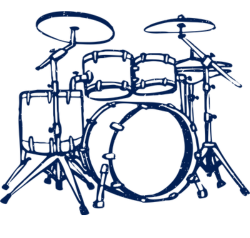
1. What Are Bongo Drums?
Bongo drums are a type of Afro-Cuban percussion instrument that is commonly used in Latin music. Bongo drums are usually played as part of a larger percussion ensemble, such as a marimba or conga line. They are also sometimes used as part of a jazz or rock band.
The bongo drum is composed of two small drums, one larger than the other, and is held between the legs. The larger drum is called the hembra, while the smaller drum is called the macho. The drums are made of wood or metal and are usually covered with animal skin, such as goatskin or calfskin. The drums are played with the hands, fingers, or sticks.
Bongo drums are used to provide a steady rhythm for a song, as well as to create syncopated patterns. They are also used to create a variety of musical effects, such as rolls, flams, and ruffs. Bongo drums are often used to create a bridge between different sections of a song, as well as to provide a dynamic contrast to the main rhythm.
The sound of the bongo drums is often described as being “bouncy” and “warm.” This is due to the fact that the drums are usually tuned to a lower pitch than other drums. This gives the bongos a unique sound that is often associated with Latin music.
Bongo drums are an essential part of Latin music and are often used to provide a driving beat for the entire song. They are also used in many other genres of music, such as jazz, rock, and reggae.
2. The History and Origins of Bongo Drums
Bongo drums are an essential part of Latin American music, and they have a long and interesting history. Believed to have originated in Africa, these small drums have been around for centuries and are a popular part of many different genres of music.
Origins in Africa
The earliest known bongo drums date back to the 16th century, when they were used by African tribes for religious ceremonies. The drums were often used to keep a steady beat and to create a trance-like state in the participants. These drums were then brought to the Americas during the slave trade, where they were adopted and adapted by the people of Latin America.
Development in Latin America
In Latin America, bongo drums became a popular part of many musical styles, such as mambo, salsa, and reggae. The drums were often used to provide a rhythmic accompaniment to other instruments, and they were also used to create solos. The drums became a staple of Latin American music, and they are now an integral part of many popular styles.
Modern Uses
Today, bongo drums are still popular in many genres of music, and they are often used in a variety of contexts. They are commonly used as part of a Latin-style ensemble, but they can also be used in rock, jazz, and even classical music. The drums are also used in many types of folk music, and they are often used to provide a rhythm accompaniment to other instruments.
3. Benefits of Playing Bongo Drums
Playing bongo drums is an enjoyable activity that can benefit your body, mind, and spirit. This musical instrument is relatively easy to learn and can provide a lifetime of enjoyment. Here are three of the top benefits of playing bongo drums:
Improve Your Coordination
Playing bongo drums requires coordination of your arms, hands, and feet. As you practice, you will develop better coordination and motor skills. This is especially beneficial for younger children, who will learn the fundamentals of rhythm and timing.
Strengthen Your Brain
Playing bongo drums involves more than just hand-eye coordination. It also strengthens your brain power by helping you develop a better sense of timing, as well as improve your memory and creative thinking. As you practice, you will learn to focus on the rhythm of the drums and how to keep up with it.
Relieve Stress
Playing bongo drums can be a great way to relieve stress. The steady rhythm of the drums will help to relax your body and mind. Plus, playing an instrument can be very therapeutic, allowing you to express yourself in a creative way.
No matter what your age or skill level, playing bongo drums can be a great way to enjoy music and have fun. With practice, you will be able to create beautiful rhythms and melodies that will bring a smile to your face. Plus, you will reap the physical and mental benefits of playing bongo drums.
4. Common Types of Bongo Drums
Bongo drums are a popular percussion instrument, known for their distinctive sound and easy portability. Whether you’re a beginner or a professional percussionist, you’ll find a type of bongo drum to suit your needs. Here are four of the most common types of bongo drums:
Wooden Bongo Drums
Wooden bongo drums are the most traditional type of bongo drum. They are usually made from a hardwood such as mahogany or rosewood, and feature a single head that is attached to the body of the drum with a hoop. The sound produced by wooden bongo drums is usually warm and mellow.
Fiberglass Bongo Drums
Fiberglass bongo drums are made from a fiberglass shell and feature two heads that are attached to the body of the drum with metal hoops. The sound produced by fiberglass bongo drums is usually bright and cutting. They are often used in Latin music styles such as salsa and merengue.
Metal Bongo Drums
Metal bongo drums are made from a metal shell and feature two heads that are attached to the body of the drum with metal hoops. The sound produced by metal bongo drums is usually bright and cutting. They are often used in rock and jazz music styles.
Synthetic Bongo Drums
Synthetic bongo drums are made from a synthetic shell and feature two heads that are attached to the body of the drum with metal hoops. The sound produced by synthetic bongo drums is usually bright and cutting. They are often used in electronic music styles such as house and techno.
When choosing a bongo drum, it’s important to consider the sound you want to produce and the type of music you’ll be playing. Each type of bongo drum offers its own unique sound and is suitable for different musical styles. It’s also important to consider the size and weight of the drum – wooden and fiberglass drums are usually heavier than metal and synthetic drums, so if you’re looking for a lightweight drum, metal or synthetic drums are the way to go.
5. The Best Bongo Drums for Beginners
Bongo drums are a great way to get started in the world of percussion instruments. Whether you’re looking for a new hobby or are an aspiring musician, learning to play the bongos is a great way to start.
Types of Bongo Drums
Bongo drums come in many different sizes and styles. The most common type is the traditional Cuban bongo, which consists of two drums of different sizes. The smaller drum is called the hembra and the larger drum is called the macho.
The other popular type of bongo is the Afro-Cuban bongo. This type of bongo usually has three drums, with two larger drums and one smaller drum. The two larger drums are known as the hembra and the macho, while the smaller drum is known as the requinto.
Best Bongo Drums for Beginners
When it comes to choosing the best bongo drums for beginners, there are several factors to consider. Here are some of the best bongo drums for beginners:
- Meinl HCS Bongos – These are a great choice for beginners, as they offer excellent sound quality and are easy to play. They are also quite affordable.
- LP Classic Bongos – These bongos are great for those looking for a classic sound. They are made from premium materials and are designed to produce a rich, full sound.
- Toca Freestyle Bongos – These bongos are perfect for those looking for a more modern sound. They feature unique designs and are made from durable materials.
When it comes to choosing the right bongo drums for beginners, it’s important to consider your budget, playing style, and the type of sound you want. Each of these bongos offers something different, so make sure to do your research and find the one that’s right for you.
6. Common Mistakes to Avoid When Playing Bongo Drums
Playing Bongo Drums is a great way to express yourself musically, but it can also be intimidating for beginners. There are several common mistakes that can easily be avoided with the right technique and practice.
The first mistake to avoid is playing with the wrong hand. Many beginners make the mistake of using their dominant hand for the high drum and the weaker hand for the low drum. This can lead to an uneven sound and make it difficult to play in time. It’s important to switch the hands so that the dominant hand is playing the low drum and the weaker hand is playing the high drum.
Another common mistake is not using enough force when striking the drums. Many beginners don’t use enough power and this can lead to a weak and muffled sound. The best way to achieve a loud, crisp sound is to use more force when playing. It may take some time to get used to the proper amount of force, but it will be worth it in the end.
Keeping the Drumheads Tuned
One of the most important things to remember when playing bongo drums is to keep the drumheads tuned. Over time, the drumheads can become loose and out of tune. This can lead to an uneven sound and can make it difficult to play in time. To avoid this, make sure to regularly check the drumheads and tune them as needed.
Keeping the Hands Relaxed
It’s also important to keep the hands relaxed while playing. Many beginners make the mistake of gripping the sticks too tightly. This can lead to a stiff and uncomfortable playing style and can also cause the sticks to slip out of the hands. To avoid this, make sure to keep the hands relaxed and keep the wrists loose.
Practicing Regularly
The last mistake to avoid is not practicing regularly. It’s important to dedicate some time to practice each day in order to improve your technique and build muscle memory. This will help you to become more comfortable with the instrument and will make it easier to play in time.
